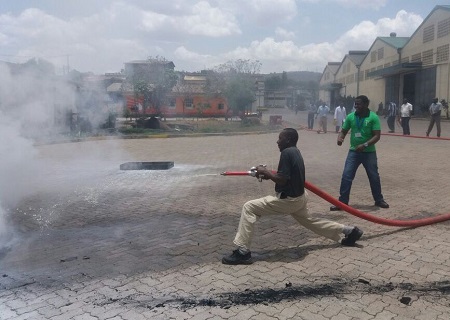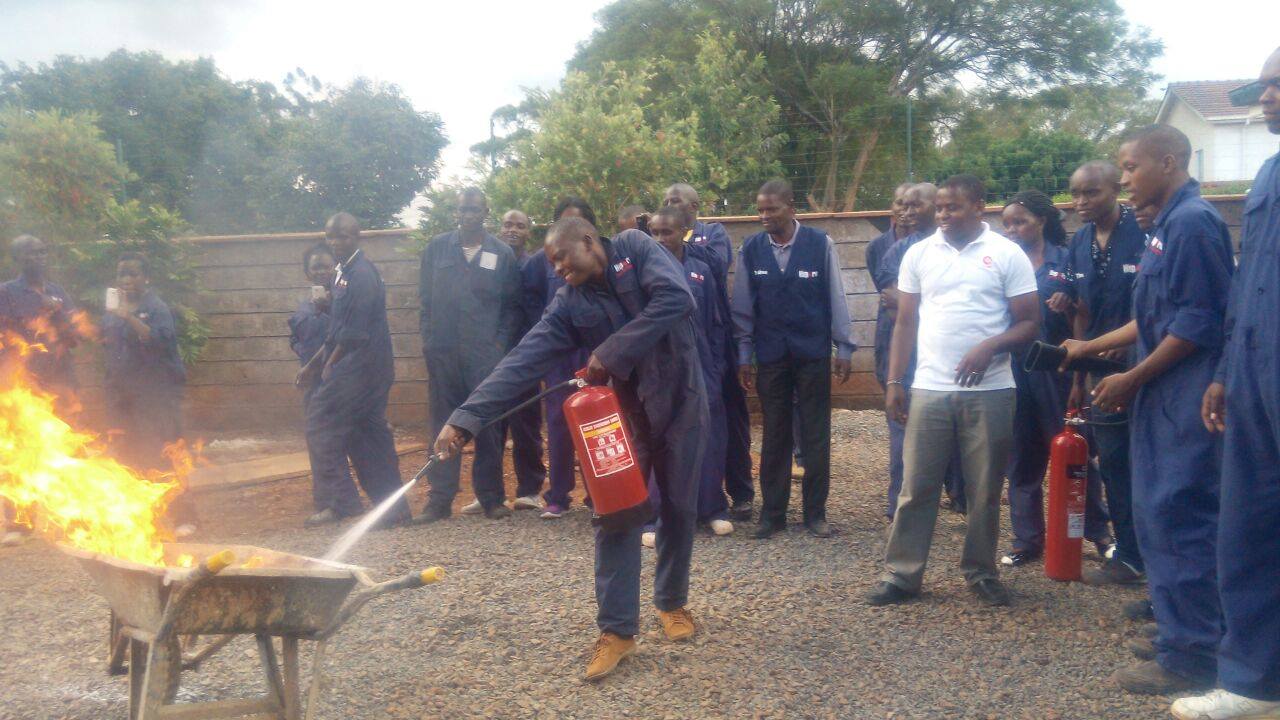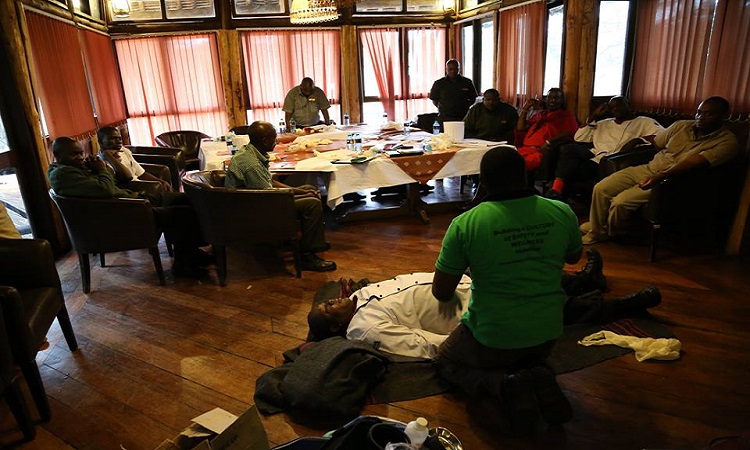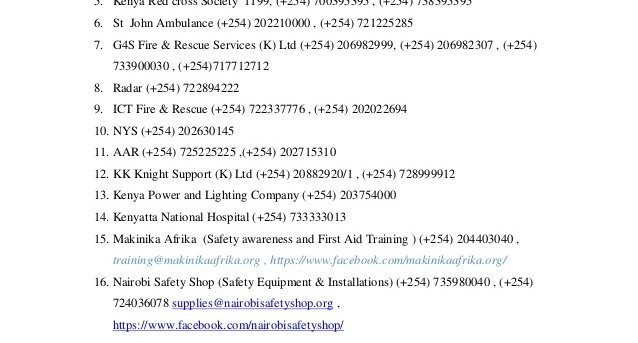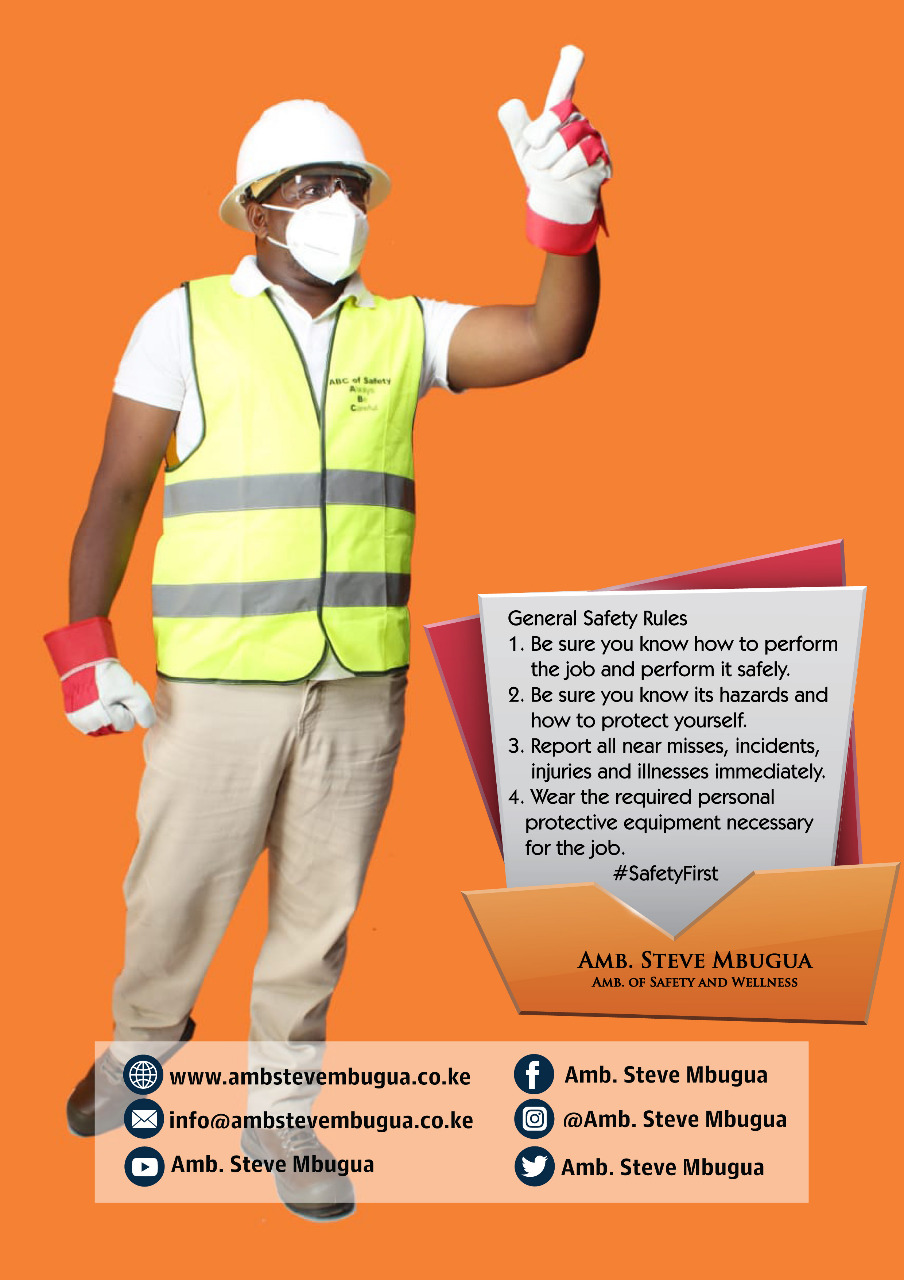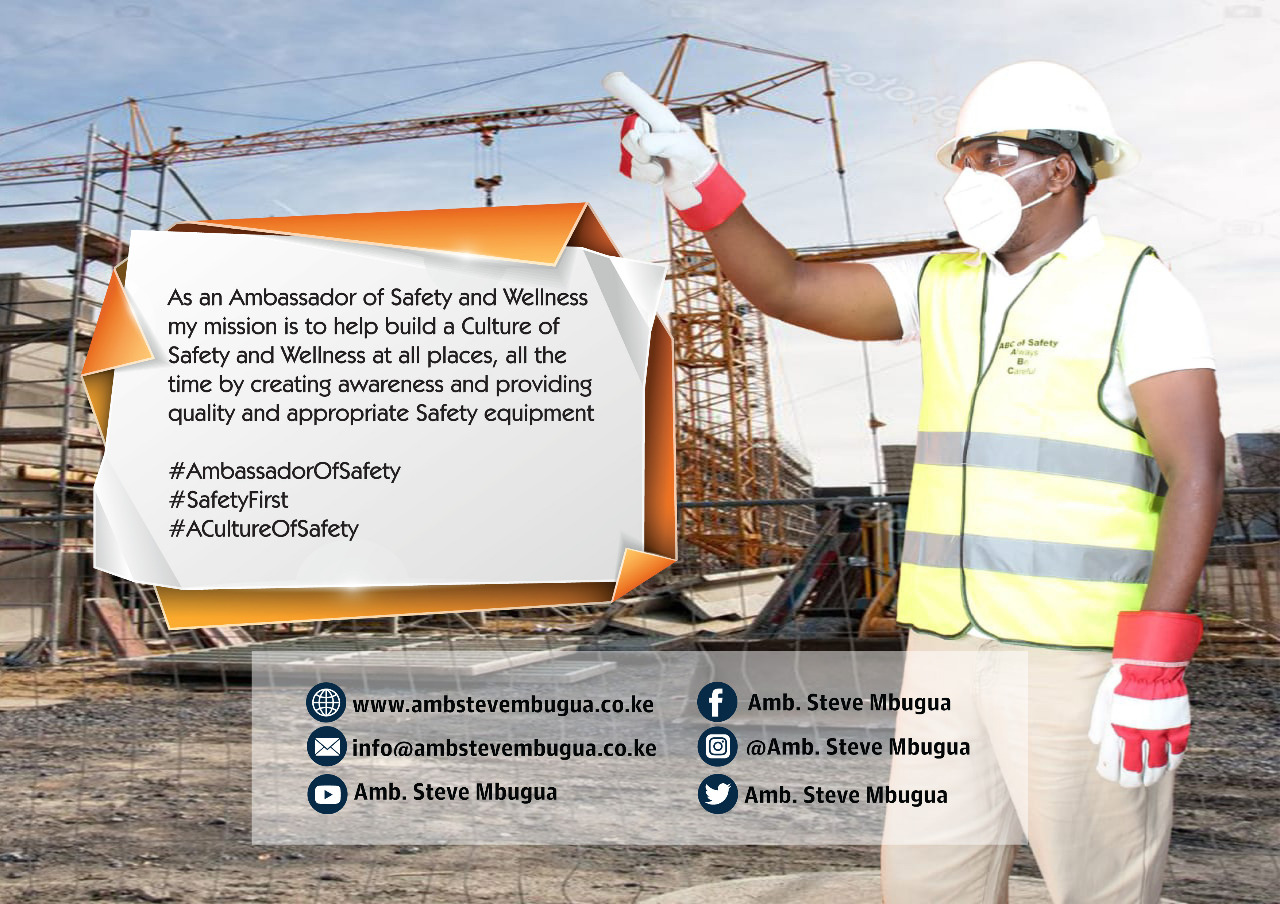As an Ambassador of Safety, my mission is to help build a culture of safety through provision of quality and appropriate Safety equipment through my companies Nairobi Safety Shop as well as equipping people with skills and knowledge that helps them prevent, prepare for and respond to incidents in a manner that is Safe, Prompt and Effective. As an Ambassador of Safety your role involves more than just advocating for safety; it requires a comprehensive approach to influence, educate, and implement effective safety practices across various settings. Here’s a detailed and expounded guide on how to fulfill this role effectively:
1. Understand Your Role and Responsibilities
1.1 Define Your Mission
• Mission Statement: Clearly articulate your mission to promote and embed a culture of safety. This includes preventing, preparing for, and responding to incidents in a manner that is safe, prompt, and effective.
• Core Responsibilities: Your primary responsibilities include advocating for safety practices, educating individuals and organizations, implementing safety protocols, and evaluating the effectiveness of safety programs.
1.2 Build Expertise
• Knowledge Base: Stay updated on the latest safety regulations, standards, and best practices. This includes understanding OSHA guidelines, ISO standards, and industry-specific safety requirements.
• Continuous Learning: Engage in ongoing professional development through courses, certifications, and industry conferences.
2. Advocate for Safety
2.1 Promote Safety Awareness
• Public Speaking: Deliver engaging presentations and workshops to educate audiences on safety topics. Use real-life examples and interactive elements to make your messages impactful.
• Media Outreach: Utilize various media platforms (e.g., social media, blogs, podcasts) to raise awareness about safety issues and share best practices.
2.2 Influence Policy and Procedures
• Policy Development: Collaborate with organizations to develop or revise safety policies and procedures. Ensure they align with regulatory requirements and reflect industry best practices.
• Advocacy Campaigns: Lead or participate in campaigns that advocate for stronger safety regulations or improvements in safety standards.
3. Educate and Train
3.1 Develop Training Programs
• Customized Training: Create tailored safety training programs based on the specific needs of different industries or organizations. Address unique risks and scenarios relevant to each audience.
• Training Materials: Develop comprehensive training materials, including manuals, videos, and interactive modules. Ensure they are accessible and easy to understand.
3.2 Deliver Training
• Workshops and Seminars: Conduct workshops and seminars that cover essential safety topics, such as hazard identification, emergency response, and safe work practices.
• Hands-On Training: Implement practical, hands-on training sessions, such as emergency drills and simulations, to reinforce theoretical knowledge.
4. Implement Safety Protocols
4.1 Conduct Risk Assessments
• Identify Hazards: Perform thorough risk assessments to identify potential hazards in various settings. This includes physical, chemical, biological, and ergonomic risks.
• Evaluate Risks: Assess the likelihood and impact of identified hazards and prioritize them based on their severity.
4.2 Develop and Implement Safety Protocols
• Safety Procedures: Create detailed safety procedures and guidelines to address identified risks. Ensure they are practical and easily implemented.
• Emergency Plans: Develop comprehensive emergency response plans, including evacuation procedures, communication strategies, and first aid protocols.
5. Foster a Safety Culture
5.1 Lead by Example
• Model Safe Behavior: Demonstrate safe practices in your own actions. Your commitment to safety will inspire others to follow suit.
• Encourage Reporting: Foster an environment where safety concerns can be reported without fear of retaliation. Encourage open communication and feedback.
5.2 Recognize and Reward
• Safety Recognition Programs: Implement programs to recognize and reward individuals and teams who excel in promoting and practicing safety.
• Celebrate Achievements: Publicly acknowledge safety milestones and achievements to reinforce the importance of safety.
6. Evaluate and Improve
6.1 Monitor and Review
• Performance Metrics: Establish metrics to evaluate the effectiveness of safety programs and initiatives. This includes tracking incident rates, training completion, and compliance levels.
• Feedback Mechanisms: Gather feedback from employees and stakeholders on safety practices and programs. Use this feedback to identify areas for improvement.
6.2 Continuous Improvement
• Review and Revise: Regularly review and update safety protocols based on feedback, new regulations, and emerging risks. Implement changes to enhance safety practices.
• Best Practices: Stay informed about best practices and innovations in safety management. Incorporate new techniques and technologies to continuously improve safety outcomes.
7. Build Relationships and Collaborate
7.1 Engage Stakeholders
• Internal Stakeholders: Work closely with internal teams, such as HR, operations, and facilities management, to integrate safety into daily operations.
• External Partners: Collaborate with external organizations, regulatory bodies, and safety experts to stay abreast of industry trends and standards.
7.2 Network and Share Knowledge
• Professional Associations: Join professional associations related to safety and risk management. Participate in networking events and forums to exchange knowledge and ideas.
• Knowledge Sharing: Share insights, case studies, and lessons learned with peers and industry colleagues to contribute to the broader safety community.
8. Lead Safety Initiatives
8.1 Develop Safety Campaigns
• Awareness Campaigns: Launch campaigns to address specific safety issues or promote safety practices. Use various communication channels to reach your target audience.
• Thematic Events: Organize events such as Safety Week or Safety Month to focus on particular safety themes and engage employees in safety activities.
8.2 Drive Safety Projects
• Safety Improvement Projects: Lead projects aimed at improving safety practices, such as introducing new safety technologies, enhancing safety training programs, or redesigning workspaces to mitigate risks.
• Research and Innovation: Conduct research on emerging safety trends and innovations. Explore and pilot new solutions that can enhance safety outcomes.
9. Maintain Professional Integrity
9.1 Adhere to Ethical Standards
• Professional Conduct: Uphold high ethical standards in all safety-related activities. Ensure that your recommendations and actions are based on evidence and best practices.
• Transparency: Be transparent about safety issues, challenges, and outcomes. Provide honest and accurate information to stakeholders.
9.2 Stay Accountable
• Responsibility: Take responsibility for the outcomes of safety initiatives and programs. Acknowledge and address any shortcomings or failures.
• Continuous Learning: Commit to personal and professional growth. Seek feedback, learn from experiences, and strive for excellence in your role as an ambassador of safety.
Being an Ambassador of Safety is a multifaceted role that requires a deep understanding of safety principles, effective advocacy, and the ability to influence and educate others. By defining your mission, promoting safety awareness, educating and training, implementing protocols, fostering a safety culture, evaluating and improving, building relationships, leading initiatives, and maintaining professional integrity, you can make a significant impact on enhancing safety and protecting lives. Your dedication and efforts in this role contribute to creating safer environments and advancing the broader goal of a culture where safety is a fundamental value and practice.
Conclusion: The Journey Towards a Culture of Safety
As we conclude our exploration of building a culture of safety, it’s essential to reflect on the journey we’ve undertaken and the pivotal role that safety plays in our organizations and communities. The principles and strategies outlined throughout this book are not merely theoretical; they are actionable guidelines designed to instill a robust safety culture that can transform workplaces and protect lives. This final chapter consolidates our learnings and underscores the enduring importance of safety.
The Essence of a Safety Culture
A culture of safety is not a destination but an ongoing journey. It represents a collective commitment to fostering environments where safety is deeply embedded in everyday practices, decisions, and interactions. This cultural shift requires more than compliance with safety regulations; it necessitates a fundamental change in attitudes and behaviors across all levels of an organization.
1. Leadership’s Role Revisited: Leadership remains the cornerstone of a successful safety culture. As emphasized throughout this book, leaders must continuously demonstrate their commitment to safety. This means actively participating in safety initiatives, supporting and endorsing safety policies, and creating an environment where safety concerns can be freely communicated and addressed. Effective leaders model safety behavior and cultivate a climate of trust, respect, and accountability.
2. Employee Engagement and Empowerment: Employee involvement is crucial for sustaining a safety culture. Engaging employees in safety practices ensures that they are not just following procedures but actively contributing to a safer work environment. Encouraging employees to take ownership of their safety and that of their colleagues fosters a sense of responsibility and collective effort. Continuous feedback, open communication channels, and involvement in decision-making processes help empower employees to be proactive in identifying and mitigating risks.
3. Ongoing Education and Training: Safety knowledge and skills must be perpetually updated to adapt to evolving risks and technological advancements. Comprehensive training programs, regular safety drills, and continuous education are essential to keep safety awareness high and ensure that employees are well-prepared to handle emergencies. Investing in training reinforces the organization’s commitment to safety and equips individuals with the tools they need to respond effectively to incidents.
4. Systematic Implementation of Safety Practices: Implementing structured safety management systems is fundamental to achieving and maintaining a culture of safety. These systems should include thorough risk assessments, hazard controls, incident reporting mechanisms, and performance monitoring. By systematically addressing safety concerns and evaluating the effectiveness of safety measures, organizations can ensure that safety practices are not only implemented but continuously refined and improved.
5. Emergency Preparedness and Resilience: Preparedness for emergencies is a critical component of a safety culture. Developing and regularly updating emergency response plans, conducting simulations, and ensuring that all employees know their roles in an emergency are essential for effective incident management. A well-prepared organization can respond swiftly and efficiently to emergencies, minimizing impact and ensuring a quicker return to normalcy.
6. Commitment to Continuous Improvement: Safety is an evolving field that requires a commitment to continuous improvement. Organizations should regularly review and update their safety practices, learn from incidents and near misses, and incorporate new safety technologies and methodologies. Embracing a mindset of continuous improvement ensures that safety practices remain relevant and effective in addressing emerging risks.
Reflecting on Successes and Challenges
As we reflect on the journey towards building a culture of safety, it is important to acknowledge both successes and challenges. Celebrating achievements reinforces positive behavior and motivates ongoing commitment to safety. Conversely, challenges should be viewed as opportunities for growth and learning. Analyzing setbacks and implementing corrective actions helps strengthen the safety culture and prepares the organization for future challenges.
The Broader Impact of a Safety Culture
The impact of a strong safety culture extends far beyond the immediate workplace. It fosters a positive organizational reputation, enhances employee well-being, and contributes to overall productivity. A commitment to safety builds trust with stakeholders, including clients, regulatory bodies, and the community, creating a foundation for sustainable success and growth.
Final Thoughts
Building a culture of safety is a dynamic and enduring process that requires dedication, collaboration, and resilience. It involves a holistic approach that integrates safety into every aspect of organizational life, from leadership and employee engagement to training and continuous improvement. By embracing the principles and practices outlined in this book, you have the tools and knowledge needed to foster a culture where safety is a shared value and an integral part of daily operations.
As we close this book, remember that the journey towards a culture of safety is continuous and ever-evolving. It demands ongoing commitment and vigilance, but the rewards are profound. A culture of safety not only protects individuals but also enhances organizational effectiveness and contributes to a healthier, more resilient society.
Together, we can create environments where safety is not just a priority but a fundamental value. Let us continue to champion safety, uphold the principles we’ve explored, and strive towards excellence in creating safe and thriving workplaces. Your dedication to building and sustaining a culture of safety makes a difference—now and for the future.
READ MORE
Building A Culture of Safety Video
Safety Ambassador
Ambassador Of Safety





